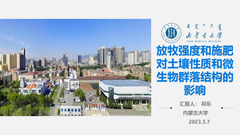报告详情
放牧强度与施肥影响典型草原土壤性质及微生物群落结构
编号:394
访问权限:私有
更新:2023-04-11 10:01:54
浏览:571次
口头报告
摘要
Appropriate grazing intensity and fertilization of nitrogen (N) and phosphorus (P) are effective measures to increase grassland productivity. In order to study the effects of grazing intensity and fertilizer application on soil properties, enzyme characteristics, soil bacterial community compositions, 12 treatments (CC, CN, CP, CNP, LC, LN, LP, LNP, HC, HN, HP, HNP) with 3 grazing intensity levels: no grazing (C), light grazing (L) and heavy grazing (H), and 4 fertilizer application levels: no fertilizer addition (C), N fertilizer addition alone, P fertilizer addition alone, both N and P fertilizers addition (NP) were conducted in a typical grassland in Xilingol, Inner Mongolia. The results showed that grazing and fertilizer application increased the input of soil nutrients, and grazing significantly increased soil dissolved organic carbon (DOC), soil total nitrogen (TN) and available phosphorus (AP); Soil alkaline hydrolysis nitrogen and total carbon were higher in LN than in LC in 0-20 cm. Soil total phosphorus and AP were higher in LP than in LN and LNP in 0-10 cm. Soil catalase (CAT) activity was decreased by 29.4%, 23.5% and 26.5%, respectively, in LNP than in LC, LN and LP in 0-10 cm. Soil CAT activity was decreased in HN and HNP than in HP in 0-20 cm. The relative abundance of Actinobacteria was increased by 38.1% and 45.0% in HC than in CC and LC, respectively, in 0-10 cm, and was increased by 35.8% and 21.7% in LN and LNP, respectively, than in LC in 0-10 cm. The relative abundance of Proteobacteria was increased in LNP than in LC in 0-10 cm. Redundancy and correlation analysis further indicated that the variation of soil C, N and P induced by grazing and fertilizer application affected the soil enzyme and bacterial diversity in the grassland soil.
关键词
暂无
报告人

祁乐
内蒙古大学稿件作者
全部评论
重要日期
-
会议日期
05月05日
2023
至05月08日
2023
-
03月31日 2023
初稿截稿日期
-
05月25日 2023
注册截止日期
主办单位
青年地学论坛理事会
中国科学院青年创新促进会地学分会
中国科学院青年创新促进会地学分会
承办单位
武汉大学
中国科学院精密测量科学与技术创新研究院
中国地质大学(武汉)
中国科学院精密测量科学与技术创新研究院
中国地质大学(武汉)



发表评论